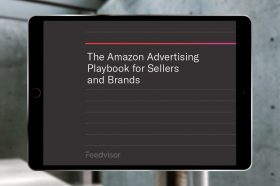Resources - Blog
The Amazon Private Label Checklist

Stay on top of the latest e-commerce and marketplace trends.
Private label products can be a phenomenal way for third-party sellers and brands to increase their margins and capture added revenue on Amazon. However, making the most of these products takes time, research, effort, and capital.
Your success depends on how well you can control and optimize your whole process, from scouting a product and sourcing it, all the way through fulfilling orders on Amazon. For sellers interested in making the leap, we put together this private label checklist to help you get started.
Brainstorming Product Ideas
Ideally, you want to find a product that you like and that can feasibly become a best seller. To brainstorm ideas, think of activities, services, or product categories that are interesting to you, then list the products associated with each. You want to create a longer list of products that you can gradually narrow down.
To increase your chances of success, you will also want to look for best selling products on Amazon with little to no competition. Before you spend the time, effort, and money to have your products manufactured, you should have a strong sense that they will sell.
The following web pages provide a quick overview of the most sought-after products on Amazon today:
Popular Product Categories
These best selling product categories are worth exploring for private label potential:
Arts, Crafts & Sewing
Baby
Home & Kitchen
Kitchen & Housewares
Office Products
Patio, Lawn, & Garden
Pet Supplies
Sports & Outdoors
Tools & Hardware
Toys & Games
Product Categories to Avoid
Aspiring private label sellers should specifically avoid the following categories:
- Product categories dominated by premium brands
- Product categories with a significant Amazon private label presence
- Amazon’s own products, like Alexa or FireTV
- Products with seasonal sales or inconsistent sales
- Products already trademarked, copyrighted, or patented
High-Performing Product Types
Although it is possible to achieve success with many different kinds of private label products, there are three product types known to perform well.
1. Essentials
Essentials never go out of season and do not usually follow one-off trends. Think beauty and grooming products, cleaning supplies, stationery, and other items that people need. Essentials are usually simple, lightweight, easy to manufacturer, and do not consist of complicated parts or mechanisms. Since the learning curve and barrier to entry are lower for these products, they are ideal for new private label sellers.
To note, sellers will need to pay particularly close attention to their margins. Rather than selling the cheapest essentials possible, you should select products that can be competitively priced between $20 and $60. Since your products are completely new and unknown to the world, you will need to earn added margin from sales to promote your products via Amazon Advertising.
2. Best Sellers With a Twist
Suitable for both new and experienced private label sellers, these products take a best selling product and add a twist to it. For example, you might take a popular iPhone case and release your own branded version in a different material. As food for thought, you can rebrand and enhance a product with a new feature, color, design, texture, or material. Just make sure not to violate copyrights for branded products.
3. Complex Products
Intended for advanced private label sellers, complex products feature a sophisticated design, usually multiple parts, and advanced functionality. Vacuum cleaners, power tools, tablets, and similarly complex products all fall within this group. Given the higher barrier to entry, these products have somewhat less competition compared to essentials. More costly to produce, complex private label products come with high risks and potentially high rewards.
How to Conduct Market and Competitor Research
Once you have a list of product ideas, you want to learn which related products sell best and have the least competition on Amazon. Third-party software platforms, like Feedvisor’s, include scouting tools that can streamline this research by tracking a variety of key Amazon metrics, such as a product’s sales numbers, the top competitors, and the most popular keywords relating to your product ideas.
If you are still warming up to the idea of a software platform, you should familiarize yourself with the following key metrics; they can help you size up the market and the competition. For private label sellers, outperforming the competition is more about overall sales numbers and market presence than winning the Buy Box.
Keywords
Since search results drive sales on Amazon, keywords are crucial to your success. You want to identify the most important keyword for your potential private label product — typically this keyword would go in your product’s name. Once you do, you will need to evaluate how popular it is. If the keyword is low-performing, you will likely not receive enough session views on your product page. If it is too popular, then you will likely have too much competition. In either case, you will need to come up with a new product idea.
Product Reviews
Product reviews are another method for understanding your competition. Search on Amazon for your main keywords and look at the first five products that show up in the results. If all of the top five products have 300+ reviews, you will want to steer clear of that product type — the competition will be too difficult to beat.
Amazon Best Sellers Rank
This best sellers rank is a metric that updates hourly according to Amazon. It highlights the top-selling products by sales volume for a product category and subcategory on Amazon. You can use it to estimate the sales frequency of a product or product category. You want your prospective product to fall within #500 to #5,000 in these rankings.
Sales Data
If you have the means, you should examine competitive sales data for products similar to yours. You want to examine similar ASINs and products with a similar look or feel. This data will not only help you gauge if an item makes sense to sell as a private label, but will also suggest how frequently it will convert. Monitoring competitor catalogs and ASINs can also help you build stronger product bundles later and strengthen your grasp on the market as a whole.
Finding a Supplier
Your supplier can have a massive impact on the profitability of your private label products. No matter which one you choose, you will typically want to prioritize quality over finding the lowest cost and you will want to inspect your inventory with every run. You should take labor and material costs, as well as currency appreciation if sourcing from overseas, into consideration when weighing your options.
Additionally, isolate your search to only the suppliers that are experienced with products similar to the ones you want to produce. Speak with them on the phone and do a site visit if possible. While Alibaba is incredibly popular, you should work exclusively with their premium gold suppliers. You can learn more about working with Alibaba here.
Find out about their minimum order requirements and have them provide detailed examples of how they will scale as your business grows. Ensure that their products go through a quality assurance process and that the items have the level of quality that you are looking for. Make sure that the supplier has experience exporting to your market of choice. For example, if you are selling on amazon.com, find a supplier with experience exporting to the United States.
Importing Your Products
When shipping your products from overseas, you will have a string of decisions to make — from choosing incoterms with your supplier to hiring a freight forwarder and customs brokers to planning a final destination for your shipment. The key is to strike a balance between your timeline, your budget, and the services offered. To more fully explore the process, go here.
Creative Branding and Competitive Diffeerntiators
Branding is the first step to ensuring that your product stands out. You will want to work with freelance creatives to produce branded product images, marketing copy, a brand story, and unique packaging. If you have a minimal budget for branding, you can hire freelancers at lower rates via Fiverr, Freelancer, or Upwork. For polished brand work at typically higher rates, check out Working Not Working or Behance.
Although you can face indirect competition with private label items, a key advantage of selling private label products is that no one else is selling your exact same item — with your exact brand, packaging, or value-added benefits. You can differentiate your private label brand through a strong value proposition and brand story, which can both in turn serve to drive brand awareness and consumer engagement.
With regard to your unique product packaging, you can leverage colors, fonts, your logo, and various design elements to draw the attention of prospective buyers. Keep your target customer profile front of mind when creating the design that will pique their interest and be sure to experiment and test packaging and product prototypes with a group of prospective buyers to garner feedback.
Ensure Brand Protection
Register your brand with a formal trademark. Without trademark registration, another brand can claim your name and you will no longer be able to sell your product. Do your research to ensure that you are not unintentionally copying another company’s concept. If your trademark is available for use, you can file your application.
Registering a trademark for your private label brand not only protects your portfolio but also helps your case when applying to Amazon’s Brand Registry. The registry gives registered brands greater influence and control over their brand’s product listings on Amazon and helps protect your brand experience by proactively removing suspected infringing or inaccurate content.
Follow Amazon’s Rules for Eligible Products
Amazon has a comprehensive list of restricted products that are prohibited from being sold on the platform. Before listing any items online, review the Restricted Products Help pages for proactive best practices and actionable guidance by category.
If you sell a product in violation of the law of any of Amazon’s policies, the company has the right to take appropriate action, including but not limited to suspension or termination of selling privileges, having your inventory destroyed without reimbursement, termination of the business relationship, or permanent withholding of payments.
Choose a Fulfillment Method
Understand your items before deciding whether you will fulfill your Amazon orders via a merchant-fulfilled operation (FBM or SFP) or through FBA. Do your items require special handling or particular packaging? Are they easily prone to damage with extreme temperature fluctuations? Do you want the Amazon Prime badge on every item you sell? When deciding on a fulfillment method, it is critical to remember that Amazon businesses are not one-size-fits-all, so the method you choose needs to align with your business goals and needs.
A general rule of thumb is that FBA is optimal if your items have fast turnover, are small, lightweight, and expensive, you do not mind commingling, and you do not have the manpower or bandwidth to fulfill efficiently and would prefer that Amazon handle the customer service portion of each transaction.
On the flip side, FBM may make more sense if your items are larger and heavier, if commingling would pose a risk for your items, and if you have storage locations and manpower to fulfill effectively while still providing a strong customer service experience. Whichever route you choose, consider the size of your operation and what kinds of items you sell.
Final Thoughts: Advertise, Optimize, and Launch
Since your product is new to the world, you will want to drive traffic to it by optimizing your listing for search and by utilizing Amazon Advertising. Amazon’s PPC advertising, such as Sponsored Product Ads and Sponsored Brands, can boost exposure especially if your product does not appear on the first page of Amazon’s SERP. To enhance your search performance, you will want to optimize your product listings for keywords.
Another one of the best ways to attract net new incremental customers is by ensuring that you have multiple positive reviews on your items. In many cases, customers are reluctant to purchase an item if it has very few reviews. Reviews should demonstrate that customers are familiar with your brand and have had a positive experience using your products.
Although Amazon does not allow sponsored or paid reviews, you can add notes to your packaging or website asking for feedback. You can also ask consumers to contact you first with any problems before leaving a negative review, so you have the opportunity to swiftly correct the situation. At the end of the day, positive reviews are critical to creating trust between you and the buyer, as well as increasing your overall sales.
Private label selling is not for the faint of heart but it is a viable strategy for unlocking new revenue for your business and further harnessing Amazon’s power. When in doubt, go that extra mile.
Learn what Feedvisor can do for your business.
When you partner with Feedvisor, you automatically receive access to our true, AI-driven technology and hands-on team of e-commerce experts. Contact one of our team members today to learn more about our end-to-end solution for brands and large sellers on Amazon, Walmart, and e-marketplaces.

![6 Ways to Prep Your Amazon Business for Success in 2019 [Guide]](https://feedvisor.com/wp-content/uploads/2018/12/6-ways-to-prep-your-Amazon-business-for-success-in-2019-01blog-280x186.jpg)
![What You Need to Know About MAP Compliance on Amazon [Guide]](https://feedvisor.com/wp-content/uploads/2018/11/What-You-Need-to-Know-About-MAP-Compliance-on-Amazon-blog-280x186.jpg)

![How Brands Can Thrive Alongside Amazon’s Private Labels [Webinar Recap]](https://feedvisor.com/wp-content/uploads/2018/12/Webinar-how-brands-can-thrive-alongside-Amazons-private-label-initiative-02-280x186.jpg)